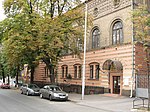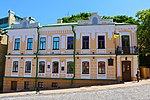National Academy of Visual Arts and Architecture
1917 establishments in UkraineEducation in the Soviet UnionEducational institutions established in 1917National Academy of Visual Arts and ArchitectureNational universities in Ukraine ... and 1 more
Universities and colleges in Kyiv

The National Academy of Visual Arts and Architecture (Ukrainian: Націона́льна акаде́мія образотво́рчого мисте́цтва і архітекту́ри; НАОМА) - is an art university in Kyiv, Ukraine specialising in visual arts and architecture. It has departaments of painting, sculpture, illustration, graphic design, stage design, architecture, Art conservation, art management.
Excerpt from the Wikipedia article National Academy of Visual Arts and Architecture (License: CC BY-SA 3.0, Authors, Images).National Academy of Visual Arts and Architecture
Voznesenskyi Descent, Kyiv Центр
Geographical coordinates (GPS) Address Nearby Places Show on map
Geographical coordinates (GPS)
| Latitude | Longitude |
|---|---|
| N 50.4587 ° | E 30.5073 ° |
Address
Voznesenskyi Descent 20
04053 Kyiv, Центр
Ukraine
Open on Google Maps










